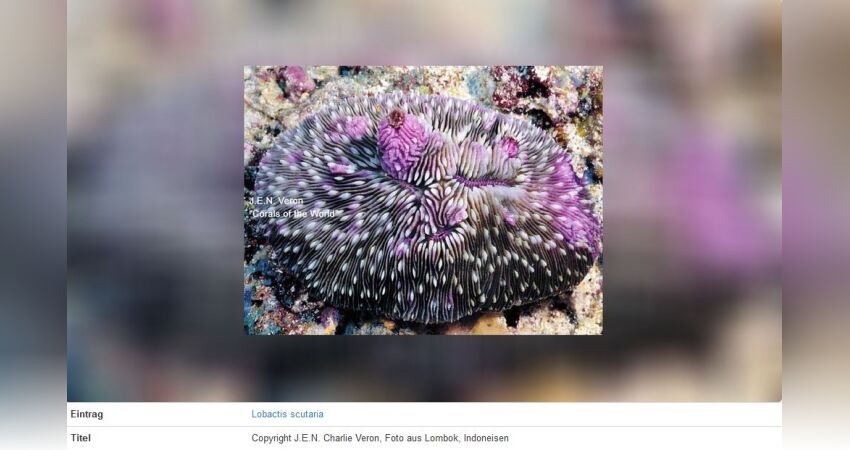FUNGIA Mushroom Corals
Fluorescence
It is still unclear what advantage the animals have from showing fluorescence in different wave ranges of visible light. Assumptions such as sole UV protection or adaptations to certain water depths have not been confirmed so far. In fact, there are many more proteins that are each excited in a narrow spectrum of visible light. When modern LED lighting is used, the various fluorescent proteins shine particularly intensely. As with other floral animals, several different fluorescent proteins can be present in a colony.
In the genus Cycloseris, this is rather less common. In Lithophyllon and Heliofungia, however, it is more common for them to fluoresce in two or three different wavelengths. Genera (in order of how often they are imported): Cycloseris, Lithophyllon, Fungia, Heliofungia, Lobactis, Polyphyllia, Herpolitha, Halomitra, Danafungia, Ctenactis Pleuractis, Sandalolitha, Podabacia, Zoophilus, Cantharellus. Smaller species belong to Cycloseris. Some others are now integrated into this genus. The two stony corals Coscinaraea wellsi and Psammocora explanulata are now placed with Cycloseris! The genus Diaseris has also been retracted. One of the most fascinating mushroom corals. It is found in large aggregations of sometimes very small polyps. The two species known so far as Diaseris, C. distorta and C. fragilis, reproduce by fragmentation. The dividing lines can already be seen on the skeleton. For these two species, it might have made sense to keep the status of a separate genus. So far they are the only free-living species that reproduce in this way! Very beautifully coloured fluorescent Cycloseris are often imported. Unfortunately, mother specimens are extremely rare, probably because they are much more likely to detach from the substrate than, say, Fungia, Lithophyllon or Heliofungia. Fungia fungites is rarely imported but is usually not strikingly coloured. Of Heliofungia fralinae there are very beautiful colour varieties that are occasionally imported. Until now only H. actiniformis belonged to the genus, now there are two! Acanthocauli are to be found regularly, unfortunately hardly ever of the coloured varieties. Such mother specimens of red or green colour forms definitely belong to experienced breeders. They die off nicely at the slightest care mistakes, which certainly happened often enough in the past. Lithophyllon contains exceptionally beautiful corals. Rare but strikingly coloured is L. concinna, and there are also magnificent specimens of L. repanda. They are quite easy to keep under favourable conditions. Lobactis scutaria is one of the most beautiful.

Similar in care to Lithophyllon. Unfortunately, this widespread species is rarely imported. The tongue corals Polyphyllia, Herpolitha come sporadically into the trade. They belong to the better keeping species. They should be carefully lifted every 4-6 weeks to check the underside of the colony for damage to the living tissue. The "bishop's cap" Halomitra pileolus is often very colourful. In the aquarium it resembles the well-known Lithophyllon. H. meierae has so far only been described from Bali and is very rarely found in the trade. It is astonishing that 36 species occur in the reefs around Bali alone. However, destruction is already very advanced there in some places. But this is by no means the most important reason in collecting for aquaristics. The reefs suffer from the many different influences of the population. The other genera Ctenactis Pleuractis, Sandalolitha, Podabacia, Zoophilus, Cantharellus are hardly ever imported. However, they include spectacular species such as Zoopilus echinatus or Ctenactis echinata. The best overview can still be found in Veron's books. However, you now have to write down the new genus classification for it! Free-living stony corals are the exception in coral reefs, only a few species from a few other families have adapted to this way of life. None of them, however, is nearly as mobile and as species-rich as the mushroom corals of the family Fungiidae.
Excerpt from the World Register of Marine Species
Cantharellus Hoeksema & Best, 1984
Ctenactis Verrill, 1864
Cycloseris Milne Edwards & Haime, 1849
Danafungia Wells, 1966
Fungia Lamarck, 1801
Halomitra Dana, 1846
Heliofungia Wells, 1966
Herpolitha Eschscholtz, 1825
Lithophyllon Rehberg, 1892
Lobactis Verrill, 1864
Pleuractis Verrill, 1864
Podabacia Milne Edwards & Haime, 1849
Polyphyllia Blainville, 1830
Sandalolitha Quelch, 1884
Sinuorota Oku, Naruse & Fukami, 2017
Zoopilus Dana, 1846
An article by Joachim Großkopf
How do you like this article?
Info
Author

Bookmark
Comments
Topics
Similar articles
- Einführung in die Nährstoffversorgung in Riffaquarien
- NEW: coral frag set - Professional Aquascaping Tools
- Keeping and propagation of Tubastrea corals
- Lederkoralle öffnet ihre Polypen nicht mehr?
- Tropic Marin® Phos-Start & Tropic Marin® Phos-Feed
- Neuigkeiten zur Pflege von Tubastrea
- Nachtschicht im Meerwasseraquarium
- Coral scions made easy - Markus Gerhardus shows us his breeding methods
- Fauna Marin CILI DIP!
- visible colour change of corals due to more blue light and UV.
Comments To the top
Please register
In order to be able to write something yourself, you must register in advance.








